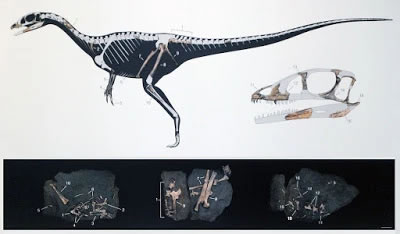
Paleontology Newsflash: Dracoraptor hanigani
Barely a month has passed in 2016, yet an important new dinosaur has already made headlines. This time it’s a Welsh critter from the early Jurassic—in fact, it’s the oldest Jurassic dinosaur known. And it has an über cool name 8}
- Tiny but mighty, the Dracoraptor measures at 7-10 feet long. No weight estimates currently exist, but it was probably lightly built, maybe 60-80 lbs. Why mighty? It may have been one of the dinosaur species to survive the extinction event at the end of the Triassic period.
- Dracoraptor means “dragon thief.” The dragon bit refers not only to its dragon-like dinosaurian form, but also to the wyvern, the dragon emblem of Wales. The “raptor” suffix does not mean it was closely related to dromaeosaurs like Velociraptor or Utahraptor; the scientists who named it claimed they used that suffix because it is “a commonly employed suffix for theropod dinosaurs.” That’s the scientific equivalent of saying “because it sounded cool.” And it does.
- It is the most complete dinosaur skeleton discovered in Wales thus far.
- Ammonite fossils were used to determine its age. Since other marine fossils were preserved with it, the corpse probably floated out to sea after it died, a scenario jocularly referred to as the “bloat and float.” As a result, its skeleton got jumbled before preservation, but enough remained to give scientists a good picture of its anatomy. Preparation remains ongoing, and scientists may yet identify more bones than first described.
- Careful preparation of this specimen has preserved more information than the remaining bones could have. Many of the bones went missing or were destroyed, but they fortunately left impressions in the rock that can tell us nearly as much. Since the fossil was discovered not 10 yards from the water’s edge, preparators had to dry the bones and their matrix slowly under damp newspaper before further work; otherwise, the fossils would have cracked and crumbled away before preparation could even begin. Those lab workers deserve credit for an amazing job.
- Its closest relatives were Tawa, Coelophysis (featured in the Park), and Daemonosaurus. Yes, Daemonosaurus. These little guys were a rough crowd.
- Very little of its behavior can be inferred at this time. Since it was found in marine deposits, the study’s authors tentatively suggest it might have been a shoreline scavenger.
- Why is this discovery so important? We have very few meat-eating dinosaurs from this time period, which makes figuring out how later dinosaurs were related much more difficult. To illustrate how rare early Jurassic theropods are, consider that we had to go to the Antarctic to find a decent one: Cryolophosaurus.
—Jeff Bond
